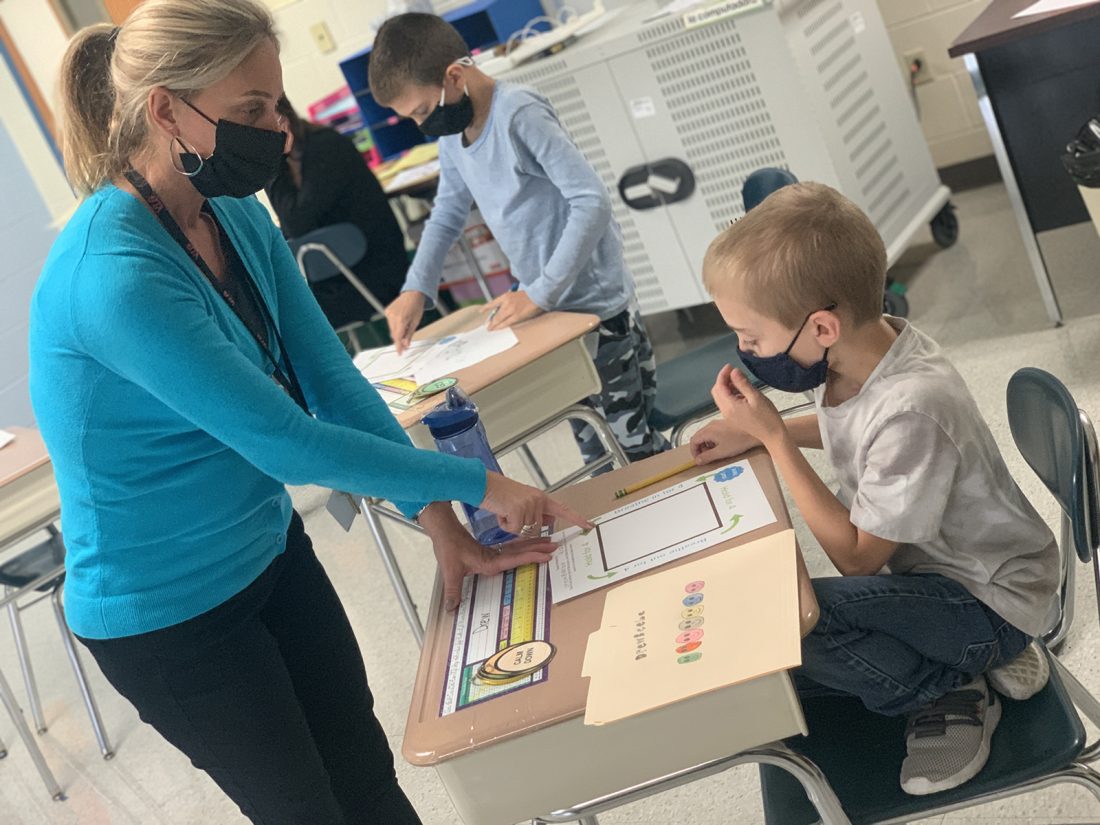How City Schools Use Social-Emotional Learning

Jefferson Middle School Counselor Kate Cusimano shows fifth grader Drew Beebe how to use a mediation worksheet and practice deep breathing while fellow student Elias Fisher practiced.
“Our talk topics today are ‘Why is it important to let go of negative thoughts?’ and ‘What is one thing I can do to distract myself from negative thoughts or feelings?” said Ring Elementary School teacher Allen Thomas to his second graders during their morning meeting. “Let’s get our share on. I want you to pair up and discuss one or both of these topics with your friend.”
The pairs chatted and then Mr. Thomas had the entire class stand at their desks and asked who would like to share what they talked about. He went around the room allowing students to voice their thoughts.
“I play games with my mom,” said a student.
“I like to breathe deeply and close my eyes,” said another student.
“Yes, doing things to take your mind completely off your negative thoughts is a great strategy. Meditation to relax your mind and talking to an adult about your negative thoughts often makes you feel better too.”
Mr. Thomas’ morning meetings start the day in his classroom. The meetings include social/emotional discussions, a “wellness check” where he asks students how they are feeling that day, talking about rules and expectations, offering a quote of the day such as focusing on doing the right thing, and showing videos with a “think about it” message such as how stress might affect a person. Mr. Thomas, like all JPS staff, continues to have a strong focus on social emotional learning (SEL) along with academics.
SEL isn’t just a feel-good activity. It gives an extra dimension to education, helping to improve cooperation, communication, and decision-making. SEL gives students a framework for developing important real-life skills. Students often come to school affected by their home life, which can affect their behavior and readiness to learn.
“SEL is key to helping academic learning happen,” said Love Elementary School second grade teacher Laurie Hind. “It allows students to think about each other and recognize good, as well as bad, behavior while encouraging students to come up with ways to help each other or even change their own reactions/behaviors. Students have gone through a lot the last two years and have gaps in their learning. Relating to each other respectfully helps create a positive environment to help them feel safe to make mistakes and continue learning.”
Many JPS schools, including Lincoln Elementary School, have also set up specific, daily SEL blocks for the entire school to ensure students are receiving information. Schools are also getting creative on how SEL is being given to students including: Puppets, Priscilla and Rocco, join Fletcher School Counselor Jillian LaMancuso for the morning announcements each day providing a fun and relatable way to talk about feelings. At Ring School, kindergarten teacher, Wendy Rodgers, reads character education books and practices breathing techniques. The class talks about different feelings and uses Play-Doh to “build” the different feelings.
Washington Middle School took an all-school approach for the beginning of the school year by building positive relationships. Teachers spent the first seven days focusing on community circles and grade level and homeroom identities. Students had a variety of activities they were involved in to build identity and relationships. The work culminated in grade level assemblies where they shared team names along with a description of why they chose that specific identity, which tied into what it takes to be a successful Washington student following their PBIS program, which changes the focus of discipline from reactionary, punitive measures to preventative, positive interactions between students and staff. These positive interactions help students develop specific social and emotional competencies, which is the ultimate goal of SEL.
JPS kindergartners to fifth grades also use the Second Step curriculum. Second Step supports the whole child by teaching skills for resolving conflicts, working with others, forming healthy relationships, and making good decisions–so students can be more successful emotionally, socially, and academically. For example, every single classroom at Bush Elementary has a Second Step Curriculum Kit. Each grade level is age appropriate, for example the kindergarten and first grade kits come with puppets. All of the grades go through the same curriculum in the same order. Currently, all of the students are learning Unit 1: Skills for Learning. Then, they will all go into Unit 2: Empathy, Unit 3: Emotion Management, and ending with Unit 4: Problem Solving. Each unit takes a quarter of the school year.
“It’s great to see students and teachers using their skills from this first unit!” said Bush Elementary School Principal Kate Benson. “I hear students saying ‘focusing eyes’ and ‘listening ears;’ and ‘calm bodies’ while they are in their various lessons throughout the day.”
School counselors are an integral part of SEL. Persell School Counselors Samantha Carroll and Jacob Wilcox, work closely with students to teach them about social emotional learning. They visit fifth and sixth grade classrooms to present lessons that focus on developing self-awareness, self-control, and interpersonal skills.
“Life during the COVID pandemic can have a lasting mental impact on everyone involved, especially students,” said Mrs. Carroll. “Some of the lessons include teaching students about anger management, managing stress, making friends, and positive self-esteem. Teaching these social-emotional concepts to students can help them learn how to be better able to problem-solve, manage their emotions, and build relationships with others. Ensuring that students have the knowledge to navigate the ever-changing world is crucial for life success. The importance of social emotional learning is that those with strong social-emotional skills are better able to cope with everyday challenges and benefit all around in life.”






